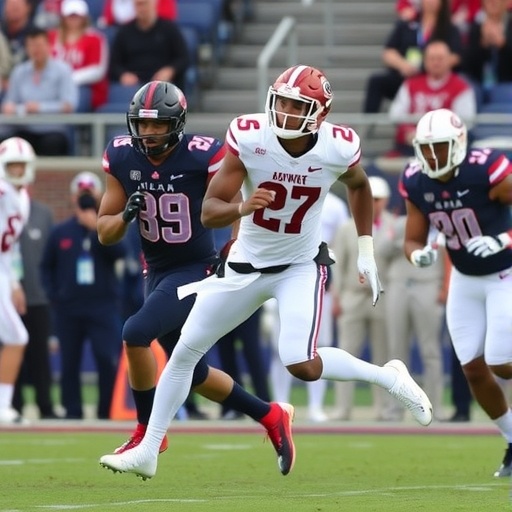Florida Atlantic Owls Pull Off Dramatic Upset Over Navy Midshipmen in College Football Thriller: Final Score and Key Stats
In a heart-pounding clash that had fans on the edge of their seats until the final whistle, the Florida Atlantic Owls secured a thrilling 24-21 victory over the Navy Midshipmen on Saturday night at FAU Stadium in Boca Raton, Florida. This college football matchup showcased the grit and determination of both teams, with the Owls’ opportunistic defense making crucial stops to edge out Navy’s relentless triple-option attack in a game that could prove pivotal for FAU’s season trajectory within the NCAA landscape.
The win marks a significant moment for the Florida Atlantic Owls, who entered the game with a 3-2 record, looking to build momentum in the American Athletic Conference. Navy, boasting a disciplined 4-1 mark, came in as slight favorites thanks to their storied rushing offense, but FAU’s home-field energy and strategic adjustments turned the tide. With the clock ticking down in the fourth quarter, a strip-sack by Owls linebacker Jason Johnson sealed the deal, preventing a potential game-tying drive and sending the home crowd into a frenzy.
This wasn’t just any college football game; it was a defensive battle interspersed with explosive plays that highlighted why both programs remain staples in the NCAA. As the Owls celebrate, questions swirl about how this upset could reshape conference standings and boost recruiting efforts for head coach Tom Herman.
Owls’ Fourth-Quarter Heroics Snatch Victory from Navy’s Grasp
The turning point in this college football thriller came in the waning minutes when the Florida Atlantic Owls’ defense, battered but unbowed, rose to the occasion against the Navy Midshipmen. Trailing 21-17 with under five minutes left, FAU quarterback Michael Johnson orchestrated a 12-play, 78-yard drive that chewed up 4:32 of clock time, culminating in a one-yard touchdown plunge by running back Corey Jones. This score, which put the Owls ahead for good, was set up by a crucial third-and-seven conversion on a slant route to wide receiver Jalen Hampton, who gained 14 yards after the catch.
Game stats from the contest paint a picture of a tightly fought affair. The Owls amassed 312 total yards, with 185 coming on the ground, while Navy dominated time of possession at 32:45 but managed only 289 yards overall. FAU’s defense, ranked 45th in the NCAA for points allowed entering the game, held Navy to just 3.2 yards per carry on 48 rushes—a stark contrast to the Midshipmen’s season average of 4.8. “Our guys showed heart tonight,” said Owls head coach Tom Herman post-game. “We knew Navy’s option game would test us, but we prepared for every angle.”
Navy’s response was immediate and fierce. Starting from their own 25-yard line, quarterback Blake Horvath—Navy’s dual-threat leader—led a no-huddle drive that reached the FAU 18. But on second down, Johnson burst through the line for a sack, forcing a fumble that safety Malik Davis recovered at the 35. This play not only ended Navy’s threat but also allowed FAU to kneel out the clock, securing the win. Horvath finished with 112 rushing yards and a touchdown, but his two interceptions—both picked off by Owls cornerbacks—proved costly. For Navy coach Ken Niumatalolo, the loss stung: “We had our chances, but turnovers killed us. Credit to FAU for capitalizing.”
The emotional weight of this drive cannot be overstated. FAU, playing in front of a raucous crowd of 18,247—their largest home attendance since 2019—fed off the energy. Jones, who rushed for 112 yards on 22 carries, was named the game’s MVP, his gritty performance echoing the Owls’ blue-collar ethos.
Navy’s Triple Option Attack Pushes Owls to the Brink
From the opening kickoff, the Navy Midshipmen asserted their identity with the triple option offense that has defined their program for decades in college football. The Midshipmen controlled the first half, racking up 156 rushing yards and scoring twice to take a 14-10 lead into the locker room. Fullback D.J. Williams was a beast, bulldozing for 98 yards and a touchdown on 18 carries, while Horvath’s misdirection plays kept the Owls’ defense guessing.
Key game stats underscore Navy’s efficiency early on: They converted 7 of 11 third downs in the first half, including a gutsy fourth-and-one stop at midfield that led to their second score—a 22-yard scamper by Horvath. The Midshipmen, who rank third in the NCAA for rushing offense at 285.4 yards per game, lived up to their billing, but FAU’s adjustments at halftime shifted the momentum. The Owls stacked the box with eight defenders on early downs, forcing Navy into predictable patterns and limiting them to 133 second-half rushing yards.
One standout sequence came midway through the third quarter when Navy marched 75 yards in 14 plays, eating over seven minutes off the clock. It ended with Williams’ second touchdown, a five-yard dive that silenced the FAU faithful. Yet, the Owls responded with a field goal on their next possession, courtesy of kicker Zach Schneider’s 42-yard boot, keeping the score within striking distance at 21-13.
Navy’s discipline shone through with zero penalties for 95 yards, compared to FAU’s three for 25. However, their passing game faltered, with Horvath completing just 4 of 9 attempts for 42 yards. This reliance on the run, while effective, left them vulnerable when FAU’s pass rush heated up. As Niumatalolo reflected, “The option is our bread and butter, but we need to mix it up more when teams load up.” This game highlighted the timeless appeal of Navy’s scheme in the modern NCAA era, where spread offenses dominate.
Standout Stars Shine in Defensive Duel
Beyond the team narratives, individual performances elevated this Florida Atlantic Owls versus Navy Midshipmen matchup into a memorable college football spectacle. For the Owls, defensive end Rashad Cheney terrorized Navy’s backfield, recording two sacks and five tackles for loss among his 11 total stops. Cheney’s pressure forced Horvath into hurried decisions, directly contributing to both interceptions. Offensively, quarterback Michael Johnson was surgical, completing 18 of 25 passes for 198 yards and a touchdown, while avoiding sacks after a shaky first quarter.
Navy’s defense, no slouch themselves—ranked 22nd in the NCAA for total defense—held FAU to 4.1 yards per play overall. Linebacker Michael Buckley led the charge with 13 tackles and a forced fumble in the second quarter that briefly swung momentum. The Midshipmen’s secondary, anchored by safety Kevin Brennan, snagged one interception and broke up four passes, limiting FAU’s big plays through the air.
Game stats reveal the balance: FAU converted 6 of 14 third downs (43%), while Navy was 9 of 18 (50%). Turnovers were the great equalizer, with each team committing two, but FAU’s came at less critical junctures. Wide receiver Jalen Hampton for the Owls hauled in seven catches for 92 yards, including a 28-yard touchdown in the second quarter that tied the game at 7-7. On the Navy side, slotback Tyger Gosson added 76 rushing yards, showcasing the depth that makes their option so hard to stop.
Post-game accolades poured in. Johnson’s poise drew praise from Herman: “He’s our leader, stepping up when we needed him most.” Horvath, despite the loss, earned respect for his 124 all-purpose yards. These performances not only padded individual stat lines but also underscored the talent pool in this NCAA contest.
Key Plays That Defined the Thriller’s Unpredictable Flow
Reliving the sequence of events in this college football thriller reveals a game scripted for drama. The opening drive set the tone: Navy’s 11-play, 67-yard march ended with Williams’ one-yard score, but FAU answered swiftly with Johnson’s 28-yard touchdown pass to Hampton, knotting it at 7-7. A blocked punt by Owls special teams specialist Evan Rodriguez in the second quarter led to a short field and Schneider’s 35-yard field goal, giving FAU a brief 10-7 edge.
The third quarter’s back-and-forth was electric. Navy’s 75-yard touchdown drive pushed them ahead 21-10, but FAU’s immediate response—a 45-yard bomb from Johnson to tight end DeAndre Smith—set up Jones’ three-yard run, pulling within 21-17. Penalties played a role too; a roughing-the-passer call on Navy extended FAU’s final drive, allowing them to control the tempo.
Defensive highlights included Cheney’s sack on Navy’s two-point conversion attempt after their second touchdown, denying extra points and keeping the margin slim. Another pivotal moment: With 8:22 left in the fourth, FAU’s fourth-down stop on Navy’s own 40-yard line flipped field position, leading to the Owls’ go-ahead score. These plays, captured in game stats showing 12 total punts and two turnovers on downs, exemplify the chess match between coordinators.
Fans and analysts alike buzzed about the intensity. ESPN’s college football desk noted, “This was vintage service academy football meets modern athleticism—pure entertainment.” The thriller’s flow kept viewers glued, boosting viewership numbers for the NCAA broadcast.
Implications for Owls’ Bowl Hopes and Navy’s Bounce-Back Campaign
As the dust settles on this Florida Atlantic Owls victory over the Navy Midshipmen, the ripple effects in college football are already being felt. For FAU, now 4-2 and tied for second in the AAC, this win catapults them into the national conversation. It improves their chances for a bowl berth—their first since 2019—potentially eyeing the Gasparilla or Birmingham Bowl. Recruiting implications are huge; Herman’s staff can point to this upset as proof of the program’s upward trajectory, drawing in-state talent wary of bigger names.
Navy, slipping to 4-2, faces a tougher road in the AAC, where every game impacts their Commander-in-Chief’s Trophy aspirations against Army and Air Force. The Midshipmen regroup for a home date against Tulsa next week, where a win could restore confidence. Niumatalolo emphasized resilience: “Losses like this build character; we’ll be better for it.”
Broader NCAA context adds layers: This game highlighted the parity in non-Power Five conferences, with FAU’s win boosting the Group of Five’s profile amid playoff expansion talks. Expect increased scouting interest in players like Johnson and Horvath as the season progresses. For fans, it’s a reminder of college football’s magic—unpredictable, passionate, and full of stories waiting to unfold in the coming weeks.
Looking ahead, FAU hosts Charlotte on October 14, a chance to extend their streak, while Navy’s schedule toughens with road trips to Notre Dame and Memphis. Both teams’ game stats from this thriller will be dissected in film rooms, shaping strategies for the marathon ahead.










